Making a price change for products is not an easy task, as it requires a good analysis of the competition and the market. The timing of price changes is almost as important as the process of price change itself, so be sure to take the step. Therefore, it is essential to analyze when to change prices of your products, in order to ensure your competitve advantage.
The matter does not come in whether to increase or decrease prices but when; this is a recurring issue in all online stores.
To solve this problem you have to have something clear at this point and that is paramount: you need to know your competitors’ price moves before you take any actions.
Here we can get to see an example of a store’s history of price changes and how that behaviour contrasts with the rest of stores.
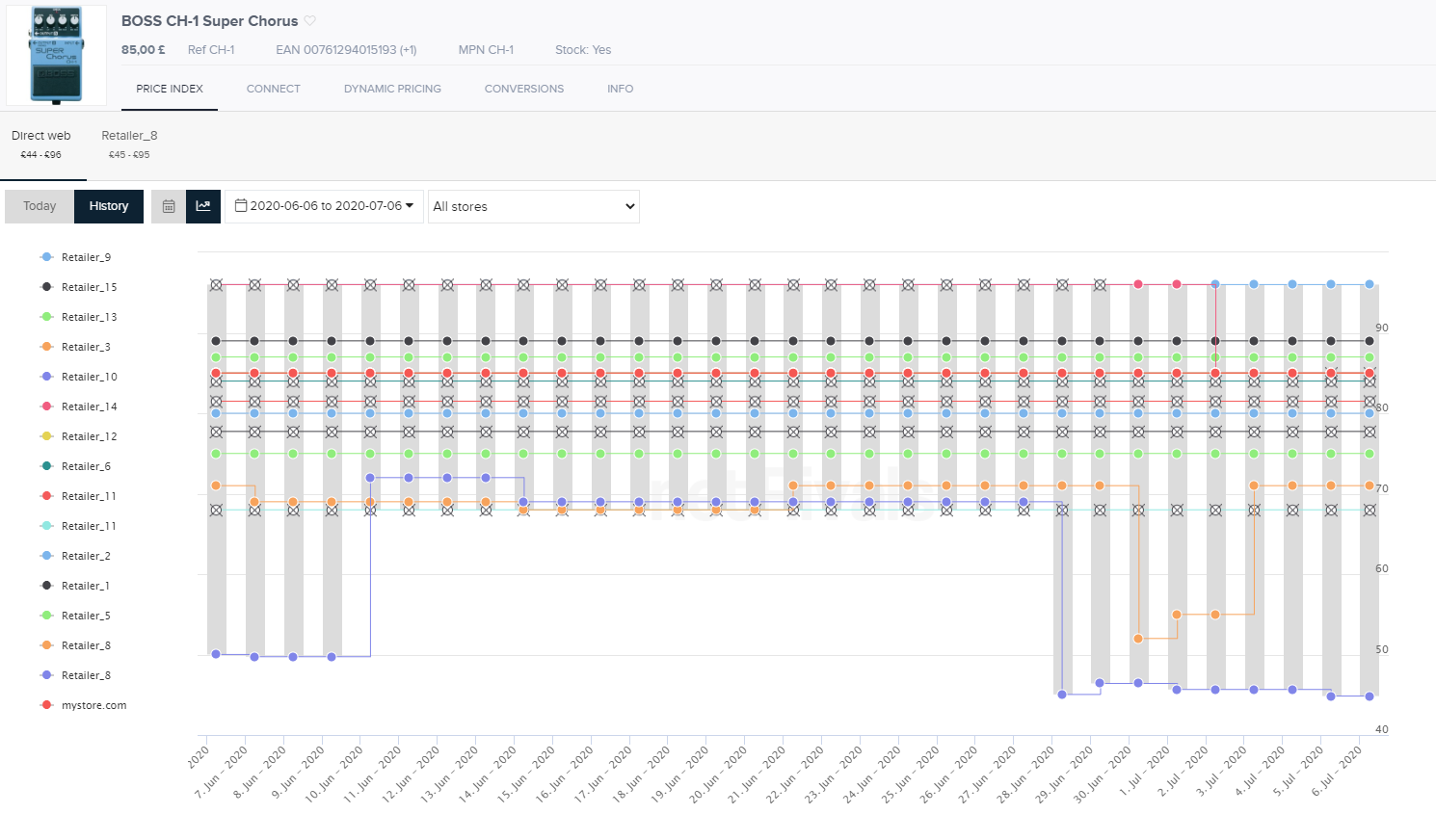
In this guide, we’ll be explaining what are the main factors to take into account to know when to change prices on your sports online store so that you can ensure you react in time to competitors’ changes.
Firstly, we’ll go through some basic concepts in order to better understand the factors that directly influence the price change.
When do your competitors change prices?
Prices can change multiple times a month, a week and, in some cases, those changes can also take place several times a day depending on which competitor we’re talking about. These changes made by competitors, of course, have an impact on your store’s positioning and performance. And sometimes a single competitor may be the one leading a price change across all stores given for a particular product. Price changes also need to be benchmark to your own competitive status and see if such price modifications leave you above, below or equal to the price of the rest of rivals competing for a specific product in the market.
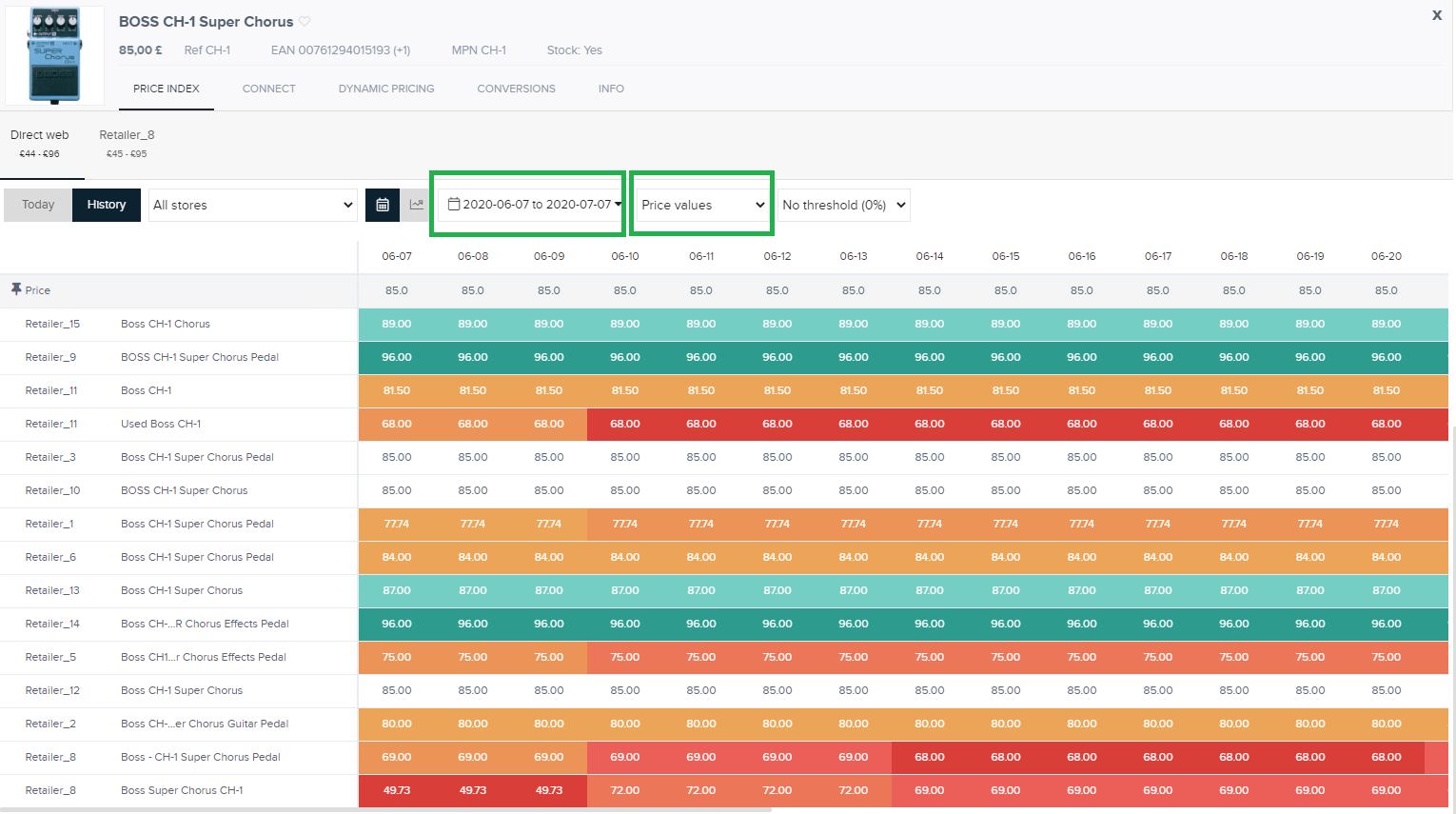
In the table above we can get to see what the price evolution has been for a given product across several competitors. And we can get to observe such price evolution from both a price value perspective and a price difference one. These perspectives give us the information about the market that we need to determine how competitive we are, and we can also even detect patterns in the pricing behaviour of our competitors.
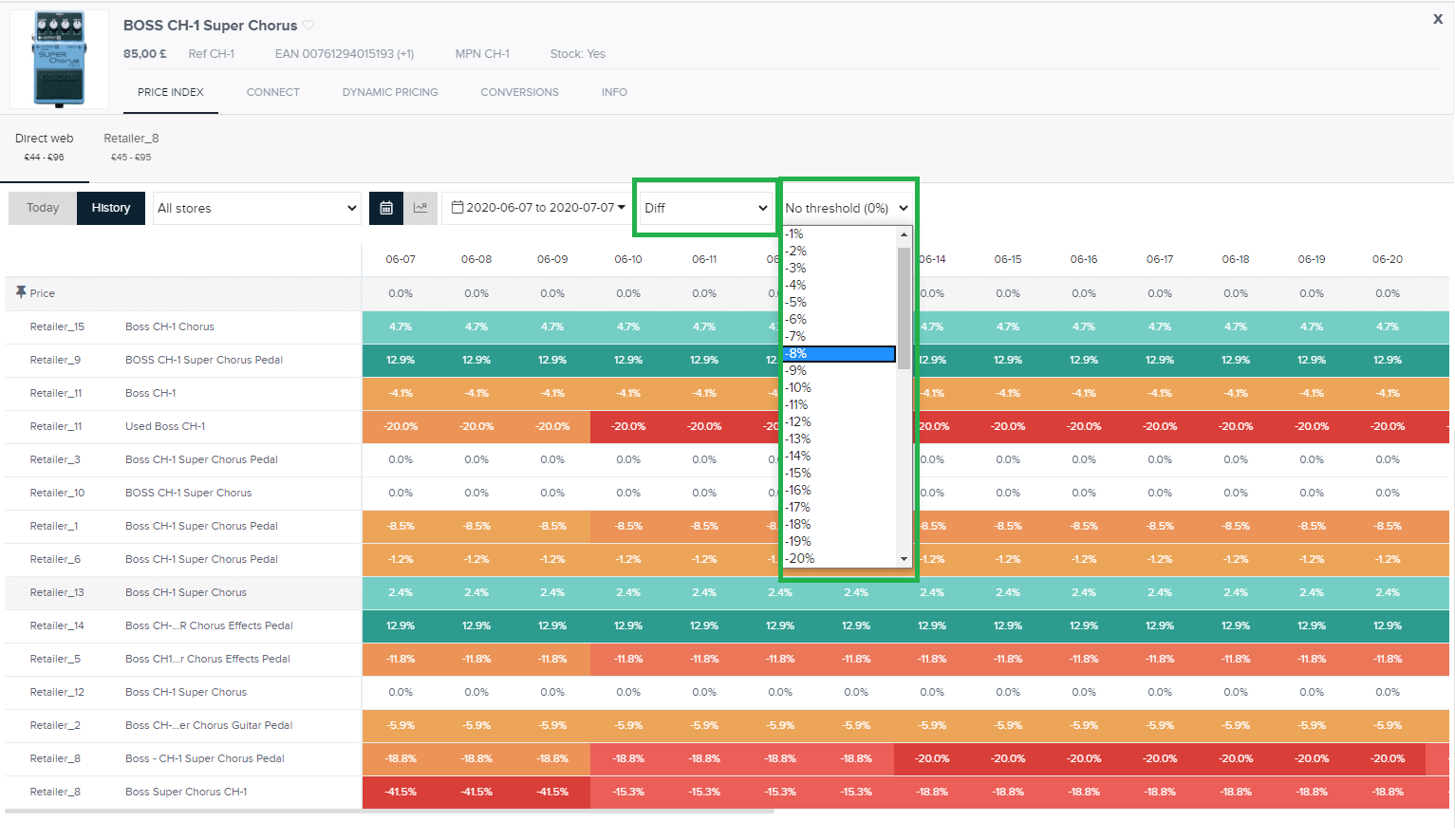
How to find out when competitors change prices
It is important to get this kind of global market picture. Nevertheless, basing your whole pricing strategy solely on this view will limit your capacity of reacting fast and in a more agile way to changes among competitors.
So, the point here is to find a way to become aware of such prices in time, since that will improve your reactive market strategy. In this respect, changes across competitors can imply lowering, increasing or equaling prices to them. So how do you become aware of it in any of the cases? Manual monitoring is not an option in this regard, so you really need to find ways to automate this process and gain time and quickness.
Also, perhaps you do not want to react to all price changes in your competitors’ catalogs and you need to specifically pay close attention to how specific brands, categories or relevant product groups for which you really want to ensure a competitive position in the market.
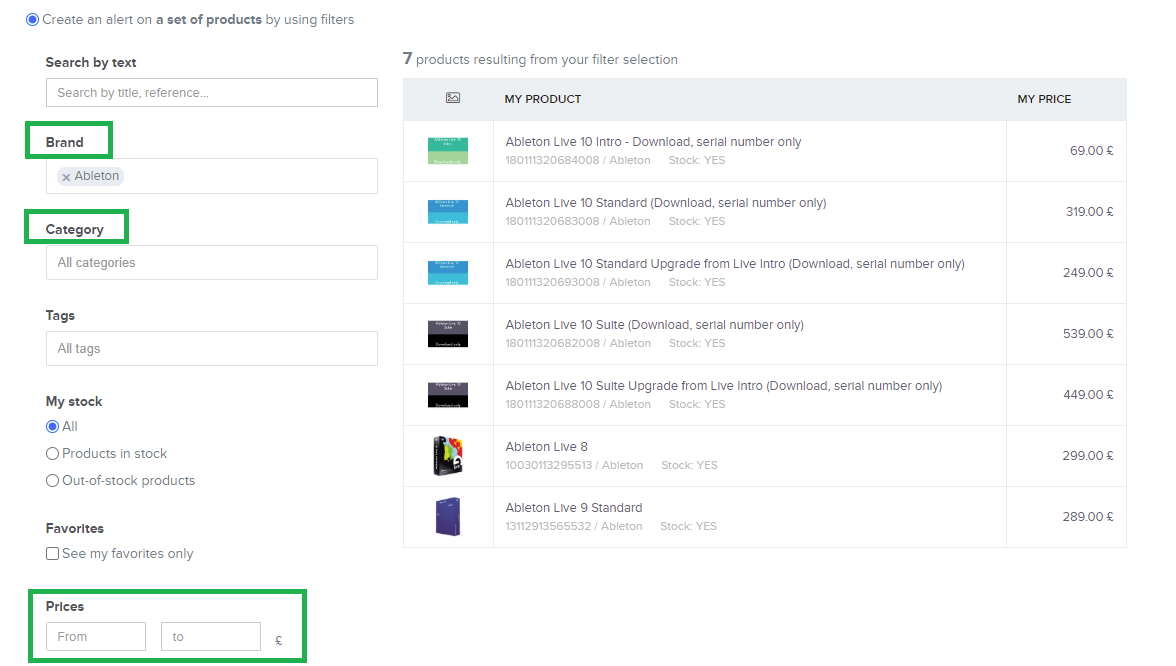
So what we see in the image above it is really interesting given that by automating the whole price change notification process, you have a wide range of options to filter your product catalog, and even get to spot price changes in products for which you compete in the market that are also included within a given price range.
How to come up with the right price change and when to apply it
Having reached this point, all of this may sound very obvious: keeping up with price changes in the market, receiving timely updates on those product price changes across competitors in the market. However, how do you react on time to such price changes to ensure your level of competitiveness? How do you come up with the right pricing to help you drive more conversions to your online store?
Getting all this updated market information will have no impact on your business performance if you do not come up with an agile procedure to change prices accordingly and in a timely way.
Suggesting new pricing for a product and repricing it can come across as a daunting task if done manually. Besides, in most cases, certain repricing rules you have established for your business apply for wider product categories, brands or even products within given price ranges. That is why it is way more convenient to find a way to automate this procedure.
In any of the cases, if you wish to change product prices wisely, of course there are paramount factors that need to be considered:
- Cost prices per given brands, categories or individual products.
- Sets of products limited by margins.
- Stock availability.
- Current competitors’ prices.
In the same way, all these factors are critical and should be part of your online store’s dynamic pricing strategy in order to timely adjust prices to market state.
What is the mix of factors involved in any successful dynamic pricing strategy?
First of all, it is key to consider the competitors that you are willing to include in your whole repricing process. Are you going to take into account all the direct competitors of your online store? Or are you only going to include or even exclude specific ones?

What is also important at this point is to bear in mind if you want to treat certain brands in your catalog differently than others. It is very common for retailers to have different degrees of flexibility concerning given brands in their catalogs. You may not want to treat them all equally, that is why you need to be very clear on the minimum margins that you want to protect for each of the brands available in your product catalog.
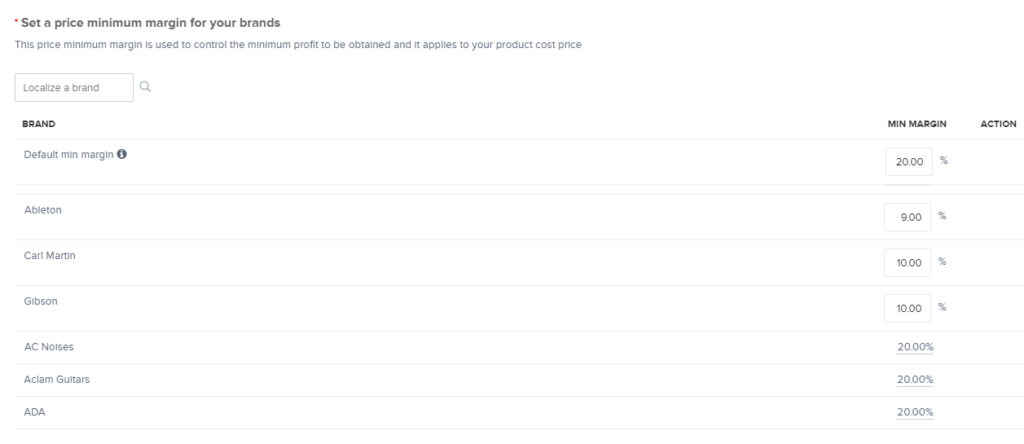
Next point to bear in mind: what is going to be your general approach in the market:
- Do you want to equal yourself to the cheapest competitor in the market?
- Do you want to equal your store’s price for a given product to a particular competitor?
- Do you want to set a lower price than the most competitive retailer for a specific product?
These are all relevant points you need to consider when elaborating your market pricing strategy.

Nevertheless, it is worth noting that it is not all about equaling or lowering prices. You also need to spot opportunities to increase your profit margins, while still driving conversions to your online stores.
Analyze products that are sensitive to repricing, check your current price and assess your current margin and profit. Does the current market scenario allow you to suggest a new price and improve your current margin and profit?

Sometimes you may find you have priced a product almost at your minimum margin. Nevertheless, given each specific market case, you may have the option of increasing your price point and still be competitive, all while optimizing your profits.

Final Thoughts
Coming up with a right pricing strategy is not based on intuition or blindly following price changes made by competitors in your sector. Your pricing decisions need to be based on real market data and you need to be consistent with what is going on in the market but also be aware of how certain decisions may impact your profit and performance. For instance, what is the point of obtaining more conversions if you are risking your profit margin? Or in a different scenario: what if you acquire competitive advantage at some point? Wouldn’t it be a great option to find opportunities to increase your margins and still acquire the conversions that you need for your online store?
The goal of this article was to provide you with ways of knowing when your competitors change prices and to help you find procedures to change and react to such price changes in time. If you build an accurate pricing strategy for your business by taking into account the market state and your own competitive factors, as well as measuring the impact that this has in your business’ conversions, you will definitely come up with a winning pricing strategy.




